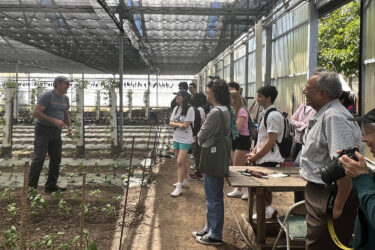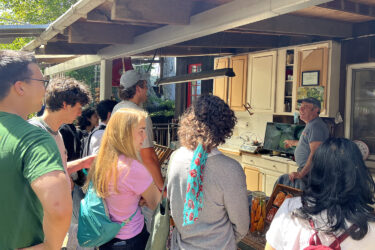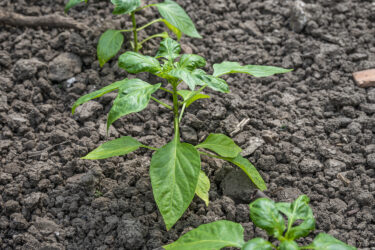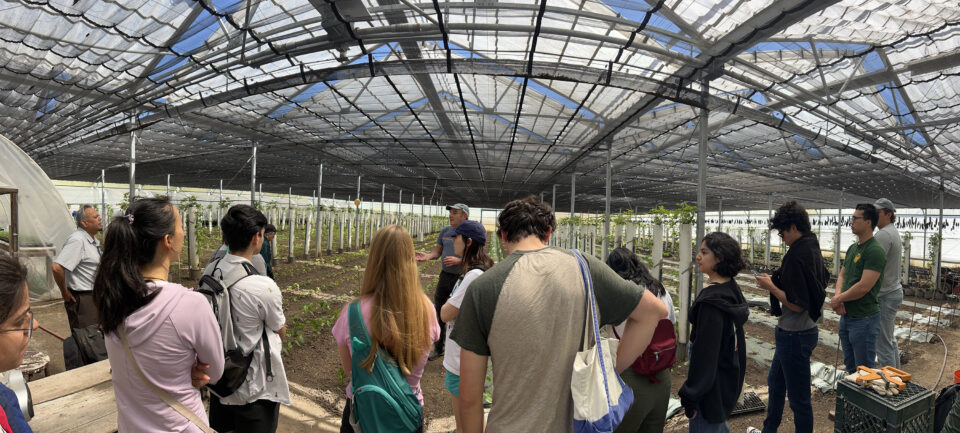Stanford course delves into the history and biology of chili peppers
A course on chili peppers covers history, anthropology, biology, and culture, and includes a visit to a specialty pepper farm in East Palo Alto.
On a warm, blue-sky Friday in May, a black charter bus rolled to a stop in East Palo Alto. Everyone on the bus looked slightly confused. This was a residential neighborhood – weren’t they touring a farm? Shripad Tuljapurkar, the class’s professor, checked the address. “This is the right place,” he declared, as 12 undergraduate students filed off the bus and gathered near the home’s mailbox.
Within minutes, a man in work pants, a blue-gray T-shirt, and a baseball cap of the same color greeted the group. David Winsberg, the owner of Happy Quail Farms, and his family have farmed this 1-acre plot since 1984. The land was originally part of the Weeks Poultry Colony, an experimental small-farm community where Charles Weeks famously developed his revolutionary chicken farming methods and “1 acre and independence” motto.
Today, most other farms are gone. But Winsberg still uses the land to produce a vast array of specialty chili peppers. “I think this is one of the last lots being farmed in East Palo Alto,” he said.
That day, he was playing tour guide to the Introductory Seminar Chilis: Biology, History, Travels, Cuisine. As suggested by its name, the course is all about chili peppers.
“This was an ideal topic for an Introductory Seminar because it includes history, anthropology, and biology,” said Tuljapurkar, the Dean and Virginia Morrison Professor of Population Studies in the School of Humanities and Sciences. Tuljapurkar specializes in population studies but loves traveling, food, and food history. “The global spread of chili peppers has led to a mixing of flavors. And a lot of civilizations that produce chili peppers contributed to that in various ways. So we talk about the positive and negative effects that global spread has had on the kinds of foods that you get to eat.”
A spicy seminar
Some students were attracted to the class because of the cultural and historical topics it advertised. Many signed up because it involved food. Good food.
In the weeks before the field trip, students savored Mexican moles, sampled Sichuan peppers, and tasted Thai curry pastes.
“I try to take some things to class,” said Tuljapurkar. “One time I took a bunch of spices. Most of them had never seen a nutmeg, or cloves. It was fun to have them actually see and touch and smell them.”
The class had also surveyed the spice trade, analyzed chili pepper anatomy and biodiversity, and traced the trade winds and ship routes that spread chili peppers from their South American origins to Europe, Asia, and Africa. They’d even visited the O’Donohue Family Stanford Educational Farm and used the facilities there to whip up a harissa, prepare a pepper-based chutney, and fry up some padróns. But they hadn’t yet seen an operating pepper farm.
The field trip came about when Tuljapurkar stumbled across Winsberg’s stand at a local farmers market. Wowed by the display, Tuljapurkar struck up a conversation and asked Winsberg if the chili class could visit the farm. Winsberg said yes.
Chili challenges on a specialty pepper farm
Behind Winsberg’s home, a greenhouse covers the back half of the 1-acre plot. Inside the greenhouse, against a backdrop of rows of freshly planted dark green pepper plants, Winsberg explained the logistics of producing up to 30 different varieties of specialty peppers. Any given year his family might be growing padróns, shishitos, cubanelles, habaneros, ají amarillos, or a rainbow of sweet bells – red, orange, yellow, lavender, or chocolate. The Winsbergs are always on the hunt for new varieties.

Image credit: Elise Overgaard

Image credit: Elise Overgaard

Image credit: Shubha Tuljapurkar

Image credit: Elise Overgaard

Image credit: Shubha Tuljapurkar
Responding to students’ burning questions, Winsberg shared his opinion on hot peppers – eating peppers is “supposed to be fun, not torture,” he said – and explained that there are ways to control a pepper’s heat. “Normally only one out of a dozen [padróns] should be hot. The trick is, if nighttime temperatures go over about 75 degrees regularly, they all get hot.” Plus they get hotter as they mature.
With such sensitivities in mind, Winsberg has had to adjust to climate change over the past few years, with later springs and shorter growing seasons. “I used to start as early as February,” he said, but on the day of the tour, several trays of young seedlings were still awaiting transplantation, living temporarily inside a greenhouse-within-a-greenhouse Winsberg built to keep delicate seedlings cozy as winter transitions to spring.
The Winsbergs sell their crops at local farmers markets and to restaurants. Fresh peppers don’t sell quickly, so he’s also added homemade sauces, purees, relishes, pickles, and, most recently, freeze-dried peppers to his product lineup. “It’s been an interesting way to make a living, but it’s certainly not easy,” he said. “The returns have really become difficult to maintain with disease pressure and market pressure in general.”
Winsberg battles powder mildew, viruses, bacteria, and bugs. “Last year probably over half of this [greenhouse] we lost to disease,” he said. “It was really a pretty sad season.”
Then there’s the human competition. “I find something like these ají amarillos that no one’s growing and start growing them, but pretty soon other farms catch on and I’ve got more competition,” Winsberg said.
His prediction for this year: “We’ll see. Farmers are always optimistic and figuring the next year is going to be the best, but you never know if you’ll get there.”
Piquant payoffs
At the end of the tour, the smiling students returned to the bus. In the coming weeks, they’d study the science of taste receptors and muse about chilis’ medicinal uses. They’d consider the globalization of chili products, debate chilis’ roles in developing personal, cultural, and national identities, and reflect on how food can be used both to unify and to exclude.
But that afternoon, the field trip was a welcome and refreshing escape from the classroom.
“It’s nice to see where they’re grown and feel them and taste them,” said senior Kasen Stephensen. “I’m an engineer; I like hands-on and practical lessons.”
For Hollis du Pont, a sophomore who grew up in the suburbs of Delaware, the tour was illuminating. “I just don’t know much about gardening or growing stuff,” she said. “It’s really cool to see this scale of production.”
Fisher Anderson, a first-year from Nashville, Tennessee, echoed du Pont’s response. “I’ve never seen a family-owned farm like that before; that was sick to see how he did it all.”
Both Anderson and du Pont recently completed another food-oriented Introductory Seminar called Chemistry in the Kitchen. While that course focused on the “nitty-gritty” science of food, they said, this course offers more space for historical, anthropological, and cultural discussions.
For Sofia Gonzalez-Rodriguez, a sophomore who helped organize the event, the trip offered a cultural connection.
“My dad is Puerto Rican, and it was cool to see this farmer grow those specialty Caribbean peppers here. It’s something I’ve never been able to find in grocery stores when I’m trying to cook Puerto Rican food,” she said. “Also, I loved seeing the family aspect of the farm.”
Many students said they appreciated how candidly Winsberg spoke about the business side of the farm. For some, it offered a new perspective.
“Growing chilis is more profitable than I thought,” said Anderson.
“I was actually going to say not as profitable as I thought,” said du Pont. “You’re really eking out a living to produce at this certain scale.”
Tuljapurkar hoped the field trip added to what they’d covered in class already. “The goal is to get students to develop a broad perspective on chili peppers and spices, especially how they enrich food and lives,” he said.
